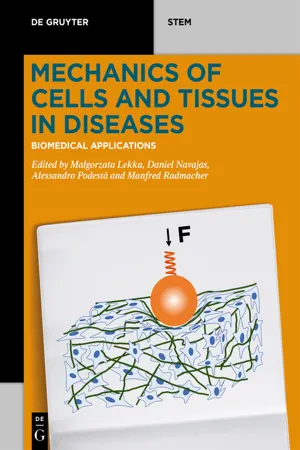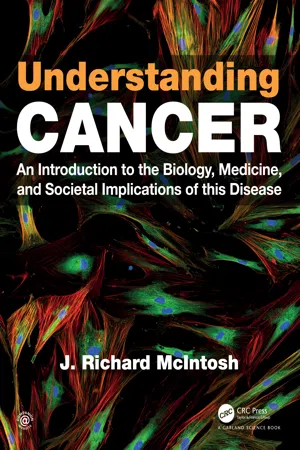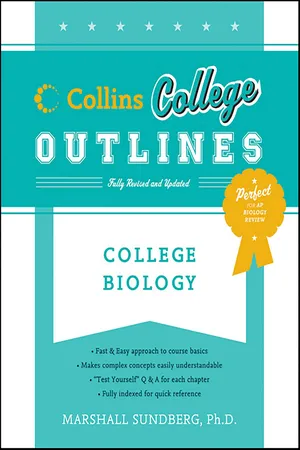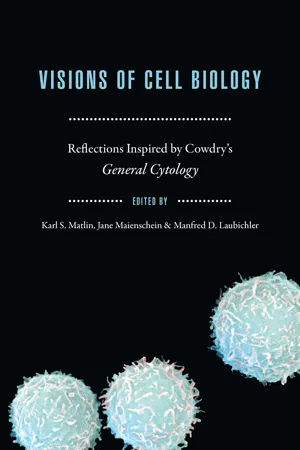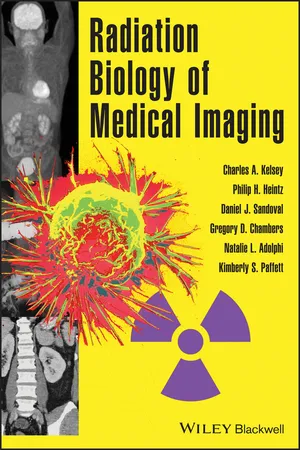Biological Sciences
Cell Structure
Cell structure refers to the arrangement and organization of the various components within a cell. These components include the cell membrane, cytoplasm, organelles such as the nucleus, mitochondria, and endoplasmic reticulum, as well as other structures that carry out specific functions. Understanding cell structure is fundamental to comprehending the processes and functions of living organisms at the cellular level.
Written by Perlego with AI-assistance
Related key terms
9 Key excerpts on "Cell Structure"
- eBook - ePub
- Malgorzata Lekka, Daniel Navajas, Manfred Radmacher, Alessandro Podestà, Malgorzata Lekka, Daniel Navajas, Manfred Radmacher, Alessandro Podestà(Authors)
- 2023(Publication Date)
- De Gruyter(Publisher)
Cell and Tissue Structure
4.1 Cell Structure: An Overview
Małgorzata LekkaInstitute of Nuclear Physics, Polish Academy of Sciences , Kraków , PolandIn living organisms, molecules subject to all the physical laws form spatial complex (bio)chemical structures capable of extracting energy from their environment and using it to build and maintain their internal structure. Each component of a living organism has specific functions at organ and cell levels that maintain cells in a steady state of internal physical and chemical conditions (homeostasis). Diseases occur due to many reasons. Some of them are linked with spontaneous alterations in the ability of a cell to proliferate, while others result from changes generated by external stimuli from the cell microenvironment. Regardless of the cause of diseases, cellular homeostasis undergoes severe alterations to which cells must adapt to survive. Otherwise, they can die. Recent studies on the role of biomechanics in maintaining cells and tissue homeostasis in various pathologies show that it is extremely important to link physical and chemical phenomena with the alterations in the structure of living cells or tissue. Accordingly, in this chapter, basic structural elements are described.A cell is an individual unit containing various organelles used to maintain all living functions (Lodish et al., 2004 ). An example of the simplest cell is a bacterium. In bacteria, all cellular processes are carried out within a single cell body. In multicellular organisms, different kinds of cells perform different functions. Cells embedded within their microenvironment (the extracellular matrix, or ECM) assemble in highly specialized tissues (connective, muscle, nervous, and epithelial) as the basis for organ formation. Despite the high level of cellular specialization, most of the animal cells possess similar cellular structures (Figure 4.1.1 - eBook - ePub
Understanding Cancer
An Introduction to the Biology, Medicine, and Societal Implications of this Disease
- J. Richard McIntosh(Author)
- 2019(Publication Date)
- Garland Science(Publisher)
The preparation of cells for microscopy is a serious issue that scientists argue over frequently. Two labs can work on the same cell type, using different methods to prepare their specimens, and get quite different results. Who is right? Sometimes it takes years to figure that out. Usually the confirmation of one view or the other comes from a different but related method that produces results which agree with one of the views but not the other. This situation makes science interesting but slow for arriving at a valid understanding of a hard problem.Through these and other scientific disciplines, scientists have learned how cells carry out the tremendous variety of functions they perform within the human body. Cells from different tissues accomplish a wide range of tasks. To do so, they display a variety of shapes, as seen in FIGURE 3.2 . Some cells are roughly cubical, some are spherical, some are elongated, and some have long arms that can make contact with other cells many cell diameters away. These different shapes help each kind of cell to do its allotted jobs effectively; the function of a cell is dependent upon its structure, including the presence of specific proteins that regulate the chemical reactions the cell can perform. Many aspects of cell biology follow from one basic idea: the structure and function of a cell’s parts contribute to the structure and function of the cell as a whole. This idea means that each cell type has distinctive features and roles, but there are some structures and functions that are common to essentially all cells. These widely used structures and processes are the focus of this chapter and the next.Cells are built as a hierarchy of structural components.
The complexity of Cell Structure is easiest to think about as a hierarchy of substructures. The smallest parts of this hierarchy are atoms, which assemble into small biological molecules, like sugars. Small molecules, in turn, join together to form macromolecules (large molecules). All cellular macromolecules are formed as chains of small molecules, linked together end-to-end to form polymers. While some cellular macromolecules function on their own, many of them assemble with others to form macromolecular complexes that can carry out intricate cellular processes: for example, the replication of DNA and the synthesis of proteins. You can see this hierarchy of cellular structures in FIGURE 3.3 - No longer available |Learn more
- Marshall Sundberg(Author)
- 2011(Publication Date)
- Collins Reference(Publisher)
CHAPTER 5Cell Structure
C ells are membrane-bound structures, composed of biological molecules, that exhibit the properties of life. Maintaining this structure is essential for life.ALL ORGANISMS ARE COMPOSED OF CELLSIn the late 1830s, it was proposed that all organisms are composed of one or more cells. This concept is one of three principles we now accept as the Cell Theory. The second principle is that cells are the smallest unit of living things. It is only when molecules organize into a cell that the emergent property of life arises. The third principle is that under the conditions found on earth today, all cells come from preexisting cells.General CharacteristicsA common feature of all cells is that they are bounded by a membrane, the plasma membrane. The term plasma refers to protoplasm, the “living stuff” of a cell. The protoplasm is a compartment separated from its environment by its outermost layer, the plasma membrane. Remember that a membrane is fluid and dynamic. It is part of the living cell.The three-dimensional structure of a cell sets up a problem in economics. The volume of protoplasm creates certain demands. To maintain life, the cell requires a minimum amount of nutrients, water and minerals, dissolved gasses, and other substances. It also must dispose of a variety of waste materials. The larger the cell, the greater its demands will be. In the simplest case, think of a three-dimensional cell as a cube with sides of equal length. The volume of a cell 1 unit on a side will be 1 unit × 1 unit × 1 unit = 13 units = 1 cubic unit. If the dimension doubles to 2 units, the volume increases as the cube, 23 = 8 cubic units. The volume of a cube 3 units on a side becomes 33 = 27 cubic units.For any living cell, the materials in demand must be transported through the plasma membrane, in one direction or the other. Nutrients and raw materials must be transported into the cell, and waste materials must be transported out. Therefore, to use an economics example, the plasma membrane determines supply. For the cell to remain alive, supply must equal demand. Unfortunately, the membrane is essentially a two-dimensional sheet whose surface area determines how much transport can occur. Surface area increases only as a square function. In a small cell (e.g., 1 unit on a side), the difference between the square and cube functions are minimal and it is easily to supply the demands of the protoplasm. As the cell increases in size, however, the difference between the cubic demand function and the squared supply function becomes substantial and at some point, becomes limiting so that the cell will stop growing. In general, the greatest dimension of a cell will be less than 100μm. - eBook - ePub
Visions of Cell Biology
Reflections Inspired by Cowdry's "General Cytology"
- Karl S. Matlin, Jane Maienschein, Manfred D. Laubichler, Karl S. Matlin, Jane Maienschein, Manfred D. Laubichler(Authors)
- 2018(Publication Date)
- University of Chicago Press(Publisher)
chapter 11 , these techniques were not able to reveal clearly the internal organization of the cell’s protoplasm. In order to help them think through how the living matter might be spatially arranged so as to achieve such things as the temporally ordered processes of metabolism or the creation and transmission of electrical charge, these “architects of the cell” (if we might call them that) drew comparisons to familiar examples of organized systems, such as laboratories, batteries, and machines.Biologists were, then, somewhat “in the dark” when it came to the cell’s internal organization, but by means of analogy and metaphor they grasped their way toward a conception of the cell as something more than a biological atom, a primitive speck of living jelly, or even an elementary organism (Kyne and Crowley 2016). They began sketching a picture or blueprint of the cell as a complex, dynamic, and highly ordered system, one whose structural and functional architecture is today understood in the modern technological terms of electronic computer circuitry and networks of signaling pathways. Our modern understanding of the cell as a complex system of molecular components with a logical architecture of genetic circuits and subroutines was traced out in an earlier time and on the model of earlier technology. A closer look at these developments in our understanding of the cell reveals both how much has changed and how much has remained the same since the 1920s.General Cytology: Uniting Structural and Functional Considerations of the Cell
At the beginning of the twentieth century, several distinct and specialized lines of investigation into the cellular basis of living organisms had developed. These included the long-established approach of descriptive morphology (“microscopical anatomy”) and the newer, more experimental and physiologically focused approaches of biochemistry, experimental embryology, and cellular genetics. As these separate ventures made progress individually and their conceptual, theoretical, and methodological principles were more fully articulated, the need for a more synthetic and integrated picture of the cell as a whole became apparent. This was the task set by a group of leading researchers which met at the Marine Biological Laboratory at Woods Hole in the summer of 1922 under the editorial direction of Edmund V. Cowdry of the Rockefeller Institute for Medical Research in New York City. - eBook - ePub
- Charles A. Kelsey, Philip H. Heintz, Gregory D. Chambers, Daniel J. Sandoval, Natalie L. Adolphi, Kimberly S. Paffett(Authors)
- 2013(Publication Date)
- Wiley-Blackwell(Publisher)
CHAPTER 2 The CellKeywordsCell cycle, organelles, cellular membrane, cellular transport, membrane junctions, p53, cellular replicationTopics- General Cell Structure, including specific organelles and their main functions
- The key points of the cell cycle
- Location of cell cycle checkpoints and the role of p53
- Membrane transport and junctions
- Description of mitosis and meiosis
- Cell death
Introduction
The basic unit of living organisms is the cell. Cells were discovered by Robert Hooke in 1665 and described as the functional unit of life. Cells have been called many things, including the smallest unit of life and the building block of life. Unicellular organisms, such as bacteria, contain only one cell throughout their lifespan whereas multicellular organisms, including humans, contain many living cells. The human body contains about 100 trillion, or 1014 , cells at any given time.In 1839, the cell theory was developed by Matthias Jakob Schleiden, Rudolf Virchow, and Theodor Schwann. The cell theory states that organisms are composed of at least one cell, and these cells originate from preexisting cells. In addition to the implication of cell division, the theory states that vital functions within the organism occur in the cell and cells contain hereditary information.This chapter discusses the basic structure of a cell. Cell Structure not only includes construction of the cell itself but also the steps taken by the cell to proliferate.Cell Structure
Cells are the basic unit of life. All organisms, whether unicellular or multicellular, begin with the function of a single cell. Cells, in general, can be divided into two types: prokaryotic, such as bacteria, and eukaryotic, such mammals. Two features separate these cell types. Prokaryotic cells contain a single external membrane to separate internal and external environments, whereas eukaryotic cells contain internal membranes in addition to their outer membrane. The internal membranes enable the cell to compartmentalize and isolate chemical reactions. In addition to internal membranes, eukaryotic cells have a cytoskeleton. The cytoskeleton provides internal structure and support for the cell. Prokaryotes lack a cytoskeleton. - eBook - ePub
Cancer
Basic Science and Clinical Aspects
- Craig A. Almeida, Sheila A. Barry(Authors)
- 2011(Publication Date)
- Wiley-Blackwell(Publisher)
Possessing a conceptual framework of how living systems are organized as well as the composition, structure, and function of cells is critical to an understanding of cancer or any other form of disease. An important and unifying concept that is pervasive throughout this chapter is the relationship between structure and function.- The structure of a cell is related to its function.
- Cells are organized into tissues and tissues into organs in ways that allow them to communicate with one another and work together as a single cohesive unit in order to perform particular tasks.
- The structures of DNA and RNA enable genetic information to be efficiently stored and expressed.
- The function of a protein is highly dependent upon its structure.
- The structure and composition of cellular membranes allows for compartmentalization and segregation of functions.
The basics of Cell Structure and function learned in this chapter will be expanded upon in Chapter 3 in order to understand the events that transform a normal cell into one that is cancerous. EXPAND YOUR KNOWLEDGEFigure 2.16 The cytoskeleton and mitotic/meiotic apparatus. (a) Actin filaments are located just below the plasma membrane. (b) Intermediate filaments are located throughout the cytosol. (c) Microtubules radiate outward from the centrosome. (d) During the processes of mitosis and meiosis the centrosome is replicated and each moves to an opposite pole of the cell. Certain microtubules, termed spindle fibers, bind to the proteins at the centromeres of the chromosomes enabling the chromosomes to be pulled to opposite poles of the cell.1 Why do you think a cancer cell is considered a “rogue” cell?2 If you were given the structure of a nucleic acid molecule, how would you determine if it was an RNA or DNA molecule?3 The mRNA molecule produced from the transcription of a DNA molecule has the sequence ACGUAUGCCGAAAGUC. What is the doublestranded sequence of the DNA molecule that produced the mRNA? Which is the template strand?4 Compare the bonds between the individual glucose molecules of starch and glycogen in Figure 2.9 - eBook - ePub
- Laurie Ann Callihan(Author)
- 2013(Publication Date)
- Research & Education Association(Publisher)
CHAPTER 3 Cellular and Molecular Biology CHAPTER 3 CELLULAR AND MOLECULAR BIOLOGY Cell Structure AND FUNCTIONThe cell is the smallest and most basic unit of structure for all living things (organisms). A single organism can be unicellular (consisting of just one cell) or multicellular (consisting of many cells). A multicellular organism may have many different types of cells that differ in structure to serve different functions. Individual cells may contain organelles that assist them with specialized functions. For example, muscle cells tend to contain more mitochondria (organelles that make energy available to the cells) since muscle requires the use of extra energy.Scientists first began to describe cells after the invention of the light microscope in the mid-1600s. Antonie van Leeuwenhoek first observed tiny organisms (he called them “animalcules”) with the use of microscopes. We now know these tiny organisms were one-celled bacteria. Robert Hooke was the first to use the term “cells” when he observed cell walls of dead cork under a light microscope.In the mid-nineteenth century, two German scientists (Matthias Schleiden and Theodor Schwann) developed the cell theory . It consists of the following tenets:1. All living things are made up of one or more cells.2. Cells are the basic units of life.3. All cells come from pre-existing cells.These tenets of the cell theory developed by scientists over 150 years ago are still held today.The light microscope is useful in examining most cells and some cell organelles (such as the nucleus). However, many cell organelles are very small and require the magnification and resolution power of an electron microscope.There are two main types of cells: prokaryotic and eukaryotic. Prokaryotes - eBook - ePub
- Britannica Educational Publishing, Kara Rogers(Authors)
- 2010(Publication Date)
- Britannica Educational Publishing(Publisher)
CHAPTER 1The Nature, Function, and Evolution of CellsC ells are basic membrane-bound units that contain the fundamental molecules of life, the substances of which all living things are composed. A single cell is often a complete organism in itself, such as a bacterium or yeast. Other cells acquire specialized functions as they mature. These cells cooperate with other specialized cells and become the building blocks of large multicellular organisms—such as animals, including humans.Although cells are much larger than atoms, they are still very small. The smallest known cells are a group of tiny bacteria called mycoplasmas. Some of these single-celled organisms are spheres about 0.3 micrometre in diameter, with a total mass of 10-14 gram—equal to that of 8 billion hydrogen atoms. Cells of humans typically have a mass 400,000 times larger than the mass of a single mycoplasma bacterium, but even human cells are only about 20 micrometres across. It would require a sheet of about 10,000 human cells to cover the head of a pin, and each human organism is composed of more than 75 trillion cells.A cell functions both as an individual unit and as a contributing part of a larger organism. As an individual unit, the cell is capable of metabolizing its own nutrients, synthesizing many types of molecules, providing its own energy, and replicating itself to produce succeeding generations. It can be viewed as an enclosed vessel, within which innumerable chemical reactions take place simultaneously. These reactions are under precise control so that they contribute to the life and procreation of the cell. In a multicellular organism, cells become specialized to perform different functions through the process of differentiation. To do this, each cell keeps in constant communication with its neighbours. As it receives nutrients from and expels wastes into its surroundings, it adheres to and cooperates with other cells. Cooperative assemblies of similar cells form tissues, and a cooperation between tissues in turn forms organs, which carry out the functions necessary to sustain the life of an organism. - eBook - ePub
Fundamentals of Children and Young People's Anatomy and Physiology
A Textbook for Nursing and Healthcare Students
- Ian Peate, Elizabeth Gormley-Fleming, Ian Peate, Elizabeth Gormley-Fleming(Authors)
- 2021(Publication Date)
- Wiley-Blackwell(Publisher)
Inside the cell, many vital chemical activities take place; for example, just like humans, cells respire (breathe), consume (eat), remove waste matter (excrete), grow, metabolise (change structures and chemicals into other structures and chemicals – e.g., change food into energy) and reproduce; they also die. In addition, different types of cells carry out differing functions; all these activities (and the very structure and nature of the cell) are programmed into the cell by a unique set of instructions that they carry within them. These instructions are found in the cell’s deoxyribonucleic acid (DNA).Figure 4.1 Examples of some cells of the human body.Source: Tortora and Derrickson (2017 ), Figure 3.35, p. 99. Reproduced with permission of John Wiley and Sons, Inc.- Cells are active – carrying out specific functions.
- Cells require nutrition to survive and function. They use a system known as endocytosis in order to catch and consume nutrients – they surround and absorb organisms such as bacteria and then absorb their nutrients. These nutrients are used for the storage and release of energy, as well as for growth and for repairing any damage to themselves.
- Cells can reproduce themselves, not by means of sexual reproduction but by asexual reproduction, in which they first of all double the number of organelles and then divide with the same number and types of organelle and structure present in each half. This is known as simple fission.
- Cells excrete waste products.
- Cells react to things that irritate or stimulate them; for example, in response to threats from chemicals and viruses.
The structure of the cell
There are four main compartments of the cell:- cell membrane;
- cytoplasm;
- nucleus;
- nucleoplasm.
There are many organelles within these compartments, which are like the cell’s internal organs. These organelles perform many functions to keep cells alive and functioning.Figure 4.2 Structure of the cell.Source: Tortora and Derrickson (2017 ), Figure 3.1 , p. 61. Reproduced with permission of John Wiley and Sons, Inc.The cell membrane
As can be seen in Figure 4.2
Index pages curate the most relevant extracts from our library of academic textbooks. They’ve been created using an in-house natural language model (NLM), each adding context and meaning to key research topics.
